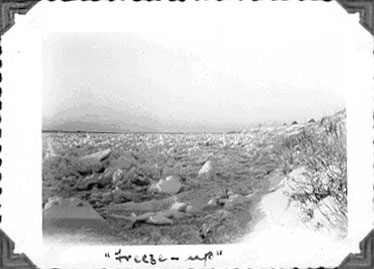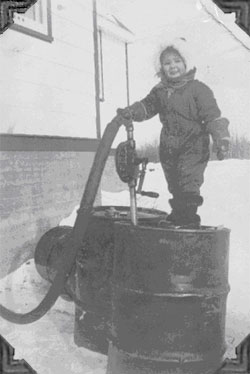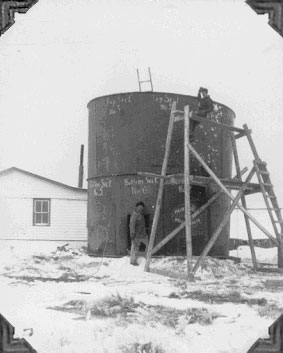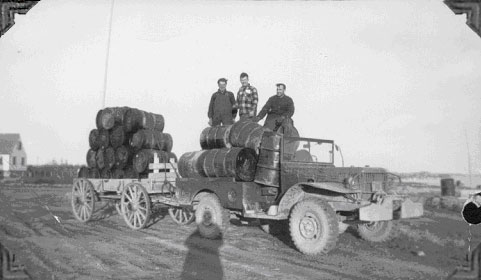Page3: Ft. Providence (continued)
Our
finished PMQ seemed positively palatial in contrast to our smaller
temporary refuge. Built to Canada Mortgage and Housing Corporation
standards it had two floors and a basement and was the tallest building
in the compound. The top floor comprised two large bedrooms, and the
ground floor had three rooms plus a kitchen and a bathroom. There
were two useful enclosed porches, one off the kitchen leading to the
back door, and one off the hall between the inner and the outer front
doors. On the ground floor three rooms and the bathroom opened into
a hallway leading from the kitchen to the front door, and the living
room also had a door to the kitchen. In the basement, two small rooms
opened off the main area, one with shelves on which to keep the year's
supplies of food, the other containing the oil tank for the furnace.
Our front door,
our sewing room, which we also used as a guest room, and one dining
room window looked onto a view of the river. The living room, with
windows on two sides, looked out on the bush and the one or two Native
cabins at our end of the settlement. One dining-room window and the
kitchen windows faced the compound, looking towards the single quarters
and, beyond that, the radio station with its high masts. If I happened
to be working at the sink beneath the kitchen window at the appropriate
time of day, I was ensured a interesting view of the morning parade
along the boardwalk from the single quarters to the two-holer.
Before our arrival,
Dick had spent some time in Edmonton on an obligatory meteorology
course at the Department of Transport (DOT) near NWT&Y HQ. He
had also been busy at the railway yards. As fall was rapidly approaching,
it was a matter of some urgency for him to check the freight trains
with the yardmaster, to find out whether the boxcar in which our furniture
was being sent from Ottawa had arrived. It still had to make a further
rail journey to Fort McMurray in time to get to Hay River. There it
had to be loaded onto a barge in time to reach Fort Providence before
the river froze for the winter. I don't know what we would have done
if it had missed the boat. The next possible date for its arrival
was the following June, after the break-up of the ice on the river!
Once we received
our furniture, which had indeed been successfully loaded on the very
last boat from Hay River before freeze-up, we were able to move into
our newly built quarters. Things were much easier then, although,
as we were to find out, perhaps seldom quite so easy as they were
"outside."
Water
We obtained our water from the Mackenzie River, whose water was fast-flowing,
pure, and unpolluted. It was interesting, but disheartening, to discover
that in the winter it was a far from easy matter to get enough water
up from the river to fill the 500-gallon tank in a corner of our basement.
The procedure involved connecting several lengths of fire hose, 400
feet in all, to reach from the basement water tank, across the front
yard and the road, down the steep riverbank, and about 90 feet out
from shore, to a waterhole that had been dug through the ice to the
water level. The next step was to take a small gas-powered pump down
to the river and start this up to force water along the hose.
A full tank would last us about three weeks. Unfortunately, filling
the tank became more and more difficult as the weather got colder.
A suitable hole had to be dug some distance from shore through six
feet of ice. The pump had to be started in the warmth of a building
before being carried down to the river edge, and the water froze in
the hoses whenever the underpowered motor stopped working, which it
did frequently. Then the hoses had to be disconnected and hung to
melt and then dry out in our basement, and the whole procedure would
have to be gone through all over again.
After one effort
on a day when the temperature was -10°F (-23°C), the final
result was one glass of water! Dick decided that modern technology
was unable to cope and that it was really easier to chop a hole in
the ice until he could reach water. Then he would bring it up to the
house two pails at a time, using a shoulder yoke.

Freeze-up
After the ice
got thicker and more difficult to break through in order to make a
hole deep enough to reach the water below, we finally ended up with
an empty 45-gallon oil drum in a corner of the kitchen in which we
melted ice that Dick had cut from the river. The water was, of course
boiled and then cooled before drinking.
It was possible
to use the washbasin, bath and toilet to their normal "outside"
extent only when the basement water tank had water in it, that is,
until cold winter weather arrived. If the water tank was empty no
water flowed from it to the water heater in the basement and water
therefore had to be heated on the kitchen stove. When we got to this
last stage it was possible to use our bathroom only for tiny baths,
standing in the baby bath set in the bathtub, which at least made
it easy to empty!
The whole water
problem was compounded by the behaviour of our septic tank, which
had been built to CMHC's southern standards. As winter advanced, it
filled up and froze! (The mission's septic tank had been insulated
with hay, and it performed perfectly throughout the year.) To solve
the toilet problem during these winter difficulties, Dick moved a
chemical toilet into the basement, emptying the bucket when necessary
down the two-holer used by the single quarters lads.

Jill demonstrates
pumping oil
Heat
Heat was provided by an oil furnace fuelled from the tank in a small
room off the main basement. The tank was filled by pumping oil from
one 45-gallon oil drum at a time with a hand pump.

Oil storage tank
In September 1949
a tall 500-barrel tank was erected in the compound to hold all the
oil from the barrels that were received in the summer. After its erection
the boys tested it by pumping river-water into it. Alas, it leaked!
But this particular ill wind did blow our family some good, as we
were able to use the testing water to fill our water tank!

Empties
Every summer the
staff had to unload, transport, and empty the oil drums brought in
by barge, and take the empty barrels back to the docking area to be
picked up by the returning barges for refilling. The only means of
transporting the barrels was the station truck, sometimes with a borrowed
cart from the mission farm attached as a trailer - and, of course,
the muscle-power of the station staff. It was a very warm, sweaty,
and mosquito-ridden business.
The subject of
oil inevitably leads me to remember the cold spring day on which our
so-far faithful furnace was reluctant to start. Referring to the manual
supplied with it, we were not amused to find that the maker's advice
in this predicament was "Contact your local dealer"! Fortunately,
that ever-resourceful station mechanic, Bob McKenzie, and Dick between
them managed to solve the problem, although poor Bob suffered singed
hair, eyebrows, and moustache in the process.
[Next
Page]
Pages: [1]
[2] [3] [4]
[5] [6]
[7] [8]
[9] [10]
[11] [12]
[13] [14]
[15] [16]
Return to top of
page
Return to the Watts
Family page